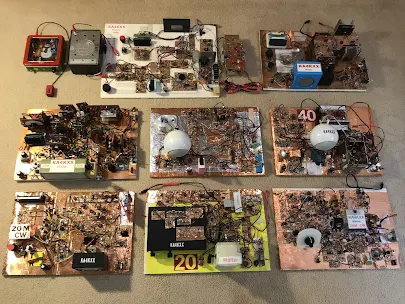Serving the worldwide community of radio-electronic homebrewers. Providing blog support to the SolderSmoke podcast: http://soldersmoke.com
Podcasting since 2005! Listen to Latest SolderSmoke
Tuesday, June 27, 2023
Australia and Apollo 11 -- Honeysuckle Creek
Monday, June 26, 2023
The Carrington Event and the Current Solar Cycle (Solar Max "Sooner and Stronger")
https://www.yahoo.com/lifestyle/see-monster-sunspot-launched-carrington-120000667.html
Friday, June 23, 2023
Part III: Curious Marc Repairs an All-Discrete Freq Counter: DO NOT ATTEMPT REPAIR OF CAVITY RESONATOR
I love all the "DO NOT ATTEMPT" warnings. Wow, even HP got so skittish about this stuff. Marc has a great sense of humor and notes that, "no cavity resonators were harmed in the production of this video." I like the description of the mixers and the photo of the mixer antennas.
Thursday, June 22, 2023
Another Podcast -- "Lamp Talk"
Another Model Rocket that Lands like SpaceX -- With a Great Description of the Flight Computer, Software, and Design
Tuesday, June 20, 2023
Part 2: CuriousMarc Fixes an All-Discrete Counter -- "Like an IC, but in discrete form."
Marc nicely sums up this project with this line: "It's an IC but in discrete form!" On the same theme, he later says, "Who needs a logic analyzer when you can do a visual debug with neon bulbs?"
Very cool. Lots of troubleshooting and repair lessons in this video:
-- Again we see the benefits of paper manuals. (Todd K7TFC commented astutely on this under yesterday's post.)
-- 2N2222s to the rescue.
-- A surprisingly large number of bad transistors (6?) found. Why did they go bad?
-- Marc repeatedly says, "Let me poke around." Poking around is often important. Mark fixes the reset line after poking around. He is not sure HOW he has fixed it, but he has... by poking around. Sometimes this happens. Thank God for small favors.
-- Marc has some fancy HP board extenders. I am jealous.
-- He also has a cool de-soldering tool. More jealousy. Want one.
-- Marc's understanding of how the HP engineers had to put one of the flip-flops "on the edge of stability," and how his 'scope probe was capable of disturbing this stability.
-- Remember that those Nixies are TUBES with enough voltage on them to really zap you. So be careful in there. This is an especially dangerous mix of transistor tech and tube tech. With transistors you can work on them with the rig fired up. With tubes, well, you have to be careful.
Part III tomorrow.
Monday, June 19, 2023
CuriousMarc Repairs an old DISCRETE COMPONENT HP Frequency Counter
Saturday, June 17, 2023
Sam WN5C Builds a Michigan Mighty Mite and Takes it to Lake Thunderbird
Wednesday, June 14, 2023
Nine Homebrew Transceivers by Walter KA4KXX (and some QRP and QRO RC planes)
I
tried a Si5351 VFO once in the dual-band rig #4, but by the time I built the
QRP Labs kit with so much closely-spaced soldering, and then added
sufficient filtering and amplification to properly drive a 50 ohm load, I
was exhausted!
These nine were created during the past eight years, and
were preceded by eight more transceivers that I can document, but those have
all been disassembled, with many of the parts being used in these later
rigs. I build my transceivers to be
operated often, and since 20 Meters has been hot lately, for example, my POTA
Hunter log shows over 300 CW and SSB contacts in 2023 alone, so rig numbers 7 -
9 have been earning their keep lately.
In summary I have created a lifetime total of seventeen transceivers so far, and although I am nowhere near the fifty-plus tally of Pete N6QW, I did spend a lot of years instead homebrewing many radio-controlled model airplanes of my own design. Two photos show one example that I flew in the 2011 Blue Max Scale R/C Contest at the Fantasy of Flight Museum in Polk City, Florida against some stiff QRO competition.
—Walter KA4KXX
Tuesday, June 13, 2023
How they Make Raspberry Pi 4 Single Board Computers
Monday, June 12, 2023
Germany: Direct Conversion Receiver Success!
Dear Bill,











